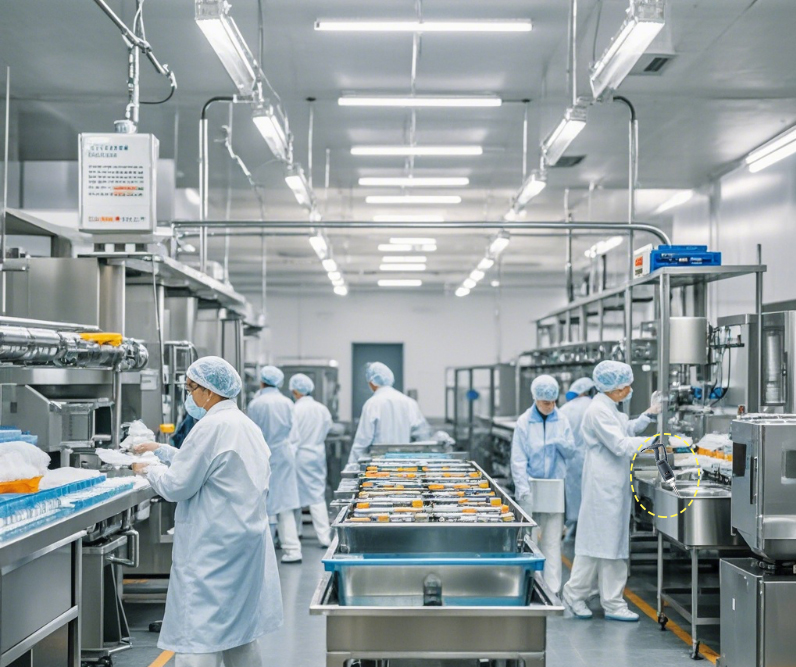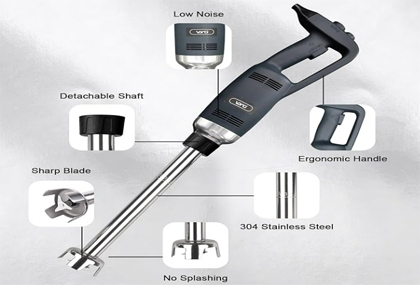Purchase Guide for Commercial Immersion Blenders
Nov 14,2024
490
In the busy operation of commercial kitchens, commercial immersion blenders can help chefs process various ingredients quickly and efficiently, ranging from blending thick soups to making delicate sauces. However, with numerous options available on the market, how can one choose the commercial immersion blender that best suits the needs of their own kitchen? Here are some key considerations.

Power and Performance
Power is an important indicator for measuring the capability of an immersion blender. For commercial environments, it is recommended to choose a blender with a power of 1000 watts or more. High power means stronger blending ability and can easily handle large quantities or ingredients with a relatively hard texture. For example, it can crush whole pieces of frozen fruits for making smoothies or turn a large amount of vegetables into a puree for making soups. Meanwhile, attention should also be paid to the quality and performance of the motor. A high-quality motor is not only powerful but also able to remain stable during long-term use, reducing the occurrence of malfunctions.
Some high-end commercial immersion blenders also have multi-speed adjustment functions, which enable chefs to flexibly adjust the blending speed according to different ingredients and production requirements. For instance, the low speed can be used to gently mix fragile ingredients such as fresh herbs and cream, while the high speed is used to crush ice cubes or tough meats.
Blending Head Design
The blending head is the part that directly contacts the ingredients and completes the blending work, and its design directly affects the blending effect. Commercial immersion blenders are usually equipped with blending heads made of stainless steel. This material is sturdy, durable, not easy to rust, and easy to clean.
There are also various shapes of blending heads, with round and flat ones being common. The round blending head is suitable for blending in deeper containers and can effectively cover a larger area; the flat blending head is more suitable for operating in frying pans or shallow containers and can better fit the bottom of the pan to ensure that the ingredients are evenly blended.
In addition, some advanced blending heads also have special blade designs. For example, serrated blades can more effectively chop ingredients with more fibers.
Material and Durability
Commercial equipment needs to withstand the test of frequent use, so the overall material and durability of the blender cannot be ignored. It is best to choose a sturdy plastic or metal material for the body shell so that it can withstand collisions and daily wear and tear in the kitchen.
Besides the blending head, the shaft of the blender should also be of good quality to prevent breakage during use. Meanwhile, it is also very important to check the sealing performance of the blender. Good sealing can prevent liquid from seeping into the motor part during the blending process, thus extending the service life of the equipment.
For commercial environments that require frequent cleaning, the waterproof performance of the blender is also crucial. A blender that can be directly rinsed with water can greatly save cleaning time and effort.
Operation Convenience
In a busy commercial kitchen, equipment with convenient operation can improve work efficiency. Choose an immersion blender with an ergonomically designed handle so that chefs will not feel hand fatigue during long-term use.
Some blenders are also equipped with easy-to-operate buttons or knobs, which are convenient for chefs to adjust the speed or turn on/off the equipment at any time during the blending process. In addition, weight is also a factor that needs to be considered. An overly heavy blender may make chefs feel strenuous during the operation, especially in the case of long-term use. Therefore, it is advisable to choose a product with a moderate weight.
Brands and After-sales Service
Well-known brands usually have stricter production standards and quality control systems, and their products have undergone long-term tests in the market. Meanwhile, after-sales service is also essential. Understanding the after-sales service network, maintenance cycle, and spare parts supply of a brand can make you feel more at ease after purchase.
From personal experience, when choosing a commercial immersion blender, factors such as power, blending head design, material, operation convenience, as well as brands and after-sales service should be considered. By carefully evaluating these aspects, you can select an efficient, durable, and convenient-to-operate immersion blender for your commercial kitchen, thereby improving the work efficiency of the kitchen and the quality of dishes.
When choosing a commercial immersion blender, factors such as power, blending head design, material, operation convenience, and brands should be considered.





